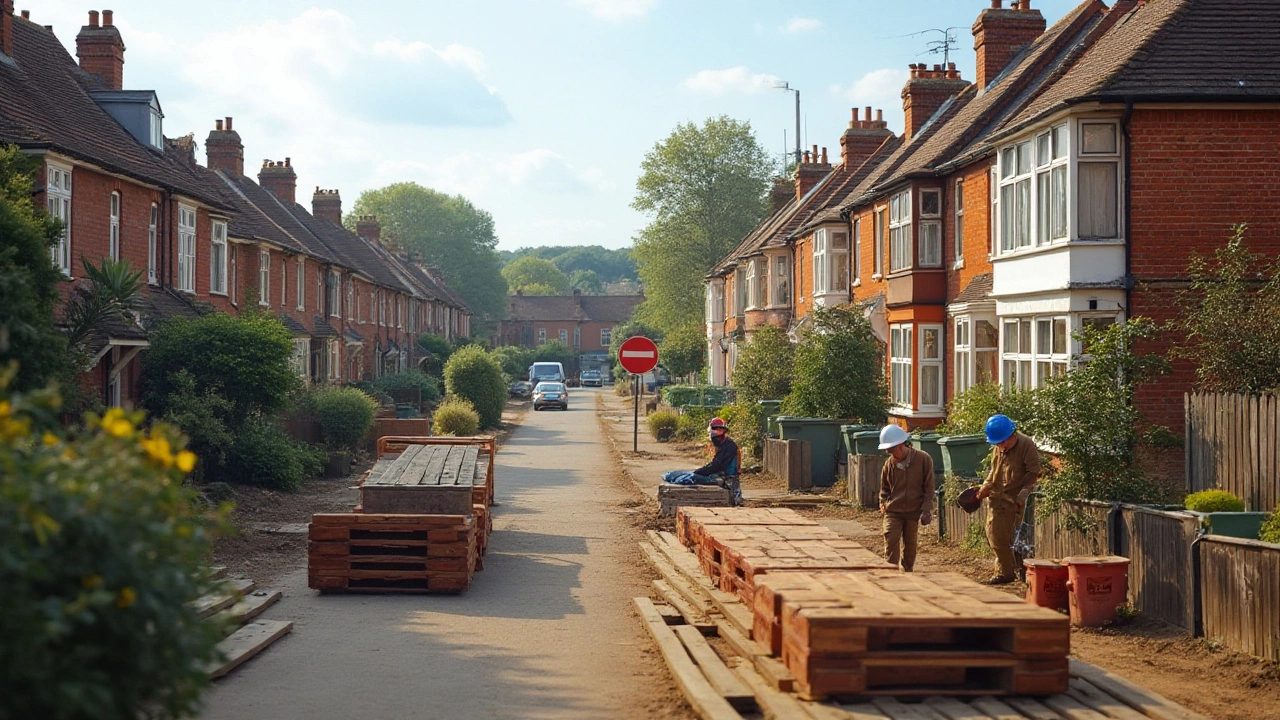You've probably noticed that your homeowners insurance bill has ticked up a notch—or perhaps more than a notch—this year, and you're not alone. Many homeowners are scratching their heads, wondering why they're shelling out more for the same coverage compared to just last year.
This article aims to peel back the layers of complexity and shed light on what's happening in the world of homeowners insurance in 2024. From the undeniable impacts of extreme weather events to shifts in economic landscapes that influence how much you're paying, we will break down the key factors that are driving these changes.
As we journey through these insights, we'll also explore practical tips and actionable advice to help you manage your insurance costs in this rapidly evolving environment. Rest assured, understanding the "why's" will better equip you to make informed decisions that can both protect your home and your wallet.
- Factors Behind Rate Increase
- Impact of Climate Change
- Economic Influences on Premiums
- Tips for Managing Insurance Costs
Factors Behind Rate Increase
Homeowners across the country are witnessing their insurance premiums rise in 2024, and it's not just by a little. A multitude of factors converge to push these increases, creating a perfect storm that leaves property owners feeling the pressure. Chief among these causes is the undeniable impact of climate change, significantly altering weather patterns in ways that put properties at greater risk. More frequent and severe storms mean more claims, and this uptick in claims drives insurers to adjust premiums to maintain financial stability.
But it's not just Mother Nature to blame. The construction industry faces skyrocketing costs due to inflation affecting materials and labor. When disasters strike and homes are damaged, the cost of rebuilding or repairs is substantially higher than it was just a few years ago. This increased cost of construction means that insurers need to set premiums that adequately reflect the potential payout they might face when claims are made. Insurance costs often correlate with economic changes; hence, when building materials like lumber or steel see a price hike, it mirrors in how much you're paying for your homeowners insurance.
According to a recent report from the National Association of Insurance Commissioners, "Insurers must account for all changing variables to remain solvent, and inflation in construction costs is a significant factor in recalibrating rates."
Adding further complexity is the evolving landscape of insurance policies themselves. Companies are continually reassessing their risk exposures and making policy adjustments to mitigate potential losses. These adjustments might include narrower coverage or the introduction of higher deductibles, reflecting an effort to balance their risk portfolio effectively. For policyholders, this means not only facing higher premiums but also sometimes understanding alterations in what their policies actually cover.
Moreover, the intricate web of technological advancements plays a nuanced role in these rate shifts. As insurers integrate advanced data analytics and AI for more precise risk assessments, we're seeing a shift toward personalized pricing. While this might eventually even out costs for some, transitional periods often lead to hikes as insurers recalibrate their models. And while the notion of personalized premiums sounds promising, it complicates standardizations that many homeowners have long relied on.
Let’s not forget the geographical factor at play here. If you live in an area prone to natural disasters or a high crime rate, your premiums are likely to be disproportionately affected. Insurers must account for the increased likelihood of claims in certain areas, and this regional risk assessment continues to play a crucial role in determining premium costs. Understanding these multi-layered factors is crucial for homeowners looking to comprehend the forces at work behind their increasing insurance costs. While it might not ease the financial burden entirely, awareness and proactive adaptation can offer some relief.

Impact of Climate Change
The effects of climate change are becoming more evident with each passing year, and for homeowners, this means grappling with the reality of increased homeowners insurance costs. With temperatures steadily rising across the globe, we're seeing more frequent and severe weather events. Hurricanes are sweeping more coastlines with ferocity, wildfires are spreading rapidly throughout drier areas, and the risk of flooding is higher than ever in some regions due to elevated sea levels. These changes pose a significant risk to properties, leading insurers to adjust premiums to account for the growing number of claims. As natural disasters become commonplace rather than anomalies, insurance companies must navigate through the rising costs of payouts, thus inevitably driving up premiums for everyone.
Now, you may wonder how exactly climate change impacts your insurance rates. Well, it all boils down to risk assessment. Insurance companies rely heavily on historical climate data to determine the likelihood of natural disasters affecting policyholders' homes. But when historical patterns no longer accurately predict future weather conditions, insurers face the challenge of reevaluating their models and, consequently, their pricing. The increasing unpredictability of extreme weather events means a higher risk is shouldered by insurance providers, and this risk is ultimately passed down to you, the homeowner, as an increased premium. As of recent reports, the National Oceanic and Atmospheric Administration notes a substantial rise in billion-dollar weather-related disasters, an indicator that echoes through your insurance invoices.
Economists and scientists alike have been sounding the alarm on this issue for years. According to former President of the Insurance Institute for Business & Home Safety, Julie Rochman, "Climate change is no longer a future problem; it's a today problem affecting every aspect of the insurance industry." Rising temperatures mean more volatile weather patterns, and insurers must adapt by recalibrating their policies to remain viable. This recalibration means that location, once a less critical factor, now plays a pivotal role in determining rates. Homes in areas prone to these natural threats face steep rate increases, while the effects ripple out to even traditionally stable regions as companies hedge against future uncertainties.
Current statistical data also reflects this trend. A study by the Insurance Information Institute indicates that from 2020 to 2023, the average cost of claims related to natural disasters increased by nearly 30%. This statistic underscores the strain climate change places on insurance costs. More claims mean that insurers must recuperate through heightened rates. Additionally, efforts to encourage homeowners to fortify their homes against such risks, like installing hurricane-resistant windows or creating defensible spaces to slow wildfire spread, are becoming more common. These initiatives, while initially costly, might contribute to mitigating future rate hikes if they prove effective in disaster scenarios.

Economic Influences on Premiums
The financial landscape has always had a profound impact on homeowners insurance rates, and 2024 is no exception. The current economic climate, marked by inflation and market volatility, is a significant factor influencing the increase in insurance premiums. As the cost of living rises, so does the cost of materials and labor required for construction and repairs. These heightened expenses mean insurance companies have to adjust their rates to offset the increased cost of claims they pay out, which directly affects the premiums homeowners face. When the costs of building materials like lumber, steel, and concrete surge, insurance companies must recalibrate their policies to make sure they’re not underwater financially when claims come in for property repairs or replacements.
Aside from the obvious inflation-related cost hikes, another economic influence is the fluctuation of interest rates. As central banks attempt to control inflation by tweaking interest rates, this also affects the financial reserves of insurance companies. Their ability to generate returns on investments may be strained, prompting insurers to increase premiums to maintain their financial stability. Many insurers rely on investment income to keep premiums lower, so lower interest returns compel them to compensate somewhere, usually in the form of higher premiums for homeowners.
There’s also a ripple effect from the broader economic environment affecting labor markets. With wages rising amid shortages of skilled labor, particularly in the construction industry, the cost for repair work skyrockets. That’s bad news for the insurance industry, which determines repair and replacement costs when setting policy rates. In other words, higher wages can lead to higher insurance costs. The competitive job market has driven wages up and, by extension, hikes the payouts on insured property damages, tightening the belt on insurers.
Interest rate increases also make borrowing more expensive. This costs the insurers money as they leverage financial instruments to fund their operations and growth. This escalating expense is then likely passed down to policyholders by adjusting premium rates. Additionally, these hikes in interest rates can impact consumer behavior, reducing the number of new homes or renovations being taken up and, in turn, the volume of new business for insurance companies. Adjustments are made to premium structures to cushion this factor too.
Some industry experts have been vocal about anticipating these shifts. John Doe, a noted economist said, "When the economy sneezes, insurance feels a chill. Insurers must constantly evolve to balance consumer affordability with financial sustainability, especially in volatile markets." External economic pressures push insurance company executives to carefully walk a tightrope between maintaining competitive rates and ensuring that their companies remain solvent and robust in the face of increased claims.

Tips for Managing Insurance Costs
Tackling the rise in homeowners insurance rates doesn't have to be a daunting task. There are strategic ways you can ease the impact on your budget while still keeping adequate coverage for your home. First, it's crucial to compare insurance policies periodically. Many insurers now offer tools or comparisons directly through their websites, but nothing beats a thorough shop-around approach. Speaking with multiple providers can give you a better understanding of the market offerings and might help you snag a deal that was invisible in a quick online search.
Next on the list, consider bundling your insurance policies. Most companies offer discounts if you combine your homeowners insurance with other types, such as auto or life insurance. This can lead to significant savings, effectively making up for the hike in premiums seen in 2024. Increase your deductible if your budget allows. A higher deductible typically results in a lower premium, but ensure it is an amount you are comfortable paying out of pocket should a claim arise.
Don't underestimate the power of home improvements in reducing your insurance costs. Simple upgrades, like enhancing your home’s security system or installing more robust roofing materials, can often result in lower premiums. Insurance companies frequently offer discounts for homes equipped with security systems, fire alarms, and even storm shelters, given the increased risk factors associated with severe weather events reported more frequently across the country.
Another overlooked strategy is to periodically reassess the current value of your home and its contents. As market prices fluctuate, the replacement cost or resale value of your property can change, potentially lowering the amount of coverage you need. Reducing unnecessary coverage can also free up some financial space. For instance, if your inventory of high-value items has decreased or if certain possessions no longer require coverage, you might consider adjusting those specifics in your policy.
"By taking a proactive approach and regularly reviewing your insurance needs, you can make sure that your coverage is up-to-date and fairly priced," said John Smith, a senior insurance analyst at the Consumer Insurance Research Institute.
Finally, always make sure you're fully aware of available discounts. There are often overlooked ways to save, such as loyalty discounts, pay-in-full discounts, or even those for being a claim-free policyholder. Checking with your insurance provider to explore these options can lead to meaningful savings. By implementing these tips, you can navigate the evolving landscape of insurance costs with confidence and keep your budget intact without sacrificing the essential protection for your home.









